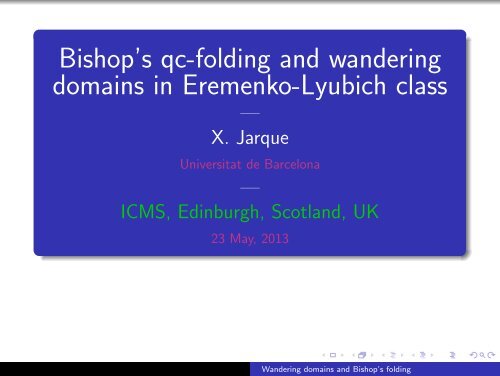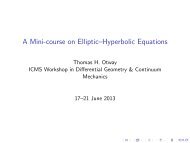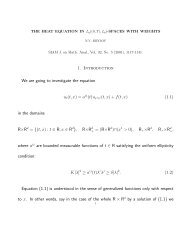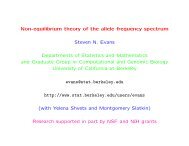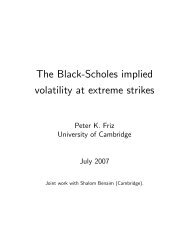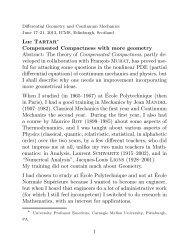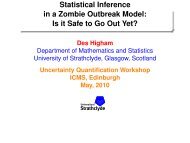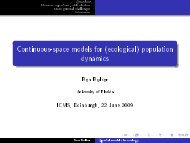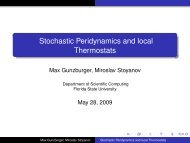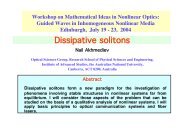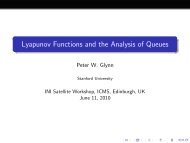Bishop's qc-folding and wandering domains in Eremenko ... - ICMS
Bishop's qc-folding and wandering domains in Eremenko ... - ICMS
Bishop's qc-folding and wandering domains in Eremenko ... - ICMS
You also want an ePaper? Increase the reach of your titles
YUMPU automatically turns print PDFs into web optimized ePapers that Google loves.
Bishop’s <strong>qc</strong>-<strong>fold<strong>in</strong>g</strong> <strong>and</strong> w<strong>and</strong>er<strong>in</strong>g<br />
<strong>doma<strong>in</strong>s</strong> <strong>in</strong> <strong>Eremenko</strong>-Lyubich class<br />
—<br />
X. Jarque<br />
Universitat de Barcelona<br />
—<br />
<strong>ICMS</strong>, Ed<strong>in</strong>burgh, Scotl<strong>and</strong>, UK<br />
23 May, 2013<br />
W<strong>and</strong>er<strong>in</strong>g <strong>doma<strong>in</strong>s</strong> <strong>and</strong> Bishop’s <strong>fold<strong>in</strong>g</strong>
Background<br />
Def<strong>in</strong>ition: Let f be a rational or entire transcendental map. Let U<br />
be a Fatou doma<strong>in</strong> of f . If f l (U), l ≥ 0 is never eventually<br />
periodic then we say that U is w<strong>and</strong>er<strong>in</strong>g. In this case we have<br />
f n (U) ∩ f m (U) = ∅ ∀n < m ∈ Z.<br />
Theorem (Sullivan 1985): Let R : Ĉ → Ĉ be a rational map <strong>and</strong><br />
let U be a Fatou doma<strong>in</strong> of R. Then f l (U) is eventually periodic<br />
for some l ≥ 0. In other words, U cannot be a w<strong>and</strong>er<strong>in</strong>g doma<strong>in</strong>.<br />
W<strong>and</strong>er<strong>in</strong>g <strong>doma<strong>in</strong>s</strong> <strong>and</strong> Bishop’s <strong>fold<strong>in</strong>g</strong>
Background<br />
Def<strong>in</strong>ition: Let f be a rational or entire transcendental map. Let U<br />
be a Fatou doma<strong>in</strong> of f . If f l (U), l ≥ 0 is never eventually<br />
periodic then we say that U is w<strong>and</strong>er<strong>in</strong>g. In this case we have<br />
f n (U) ∩ f m (U) = ∅ ∀n < m ∈ Z.<br />
Theorem (Sullivan 1985): Let R : Ĉ → Ĉ be a rational map <strong>and</strong><br />
let U be a Fatou doma<strong>in</strong> of R. Then f l (U) is eventually periodic<br />
for some l ≥ 0. In other words, U cannot be a w<strong>and</strong>er<strong>in</strong>g doma<strong>in</strong>.<br />
Remark: In what follows f will be an entire transcendental map.<br />
W<strong>and</strong>er<strong>in</strong>g <strong>doma<strong>in</strong>s</strong> <strong>and</strong> Bishop’s <strong>fold<strong>in</strong>g</strong>
Multiply-connected w<strong>and</strong>er<strong>in</strong>g doma<strong>in</strong> (Baker 1976)<br />
∏<br />
∞<br />
Let g(z) = Cz<br />
(1 2 + z )<br />
where<br />
a n<br />
n=1<br />
1 < a 1 < a 2 < . . .,<br />
a j+1 < g(a j ) < 2a n+1 ,<br />
g(A j ) ⊂ A j+1 where<br />
A j = {z ∈ C | a 2 j < |z| < √ a j+1 }.<br />
Remark: If A j ⊂ U j then g(U j ) = U j+1 , hence g k (U j ) → ∞ as<br />
k → ∞ for all j.<br />
Theorem (Baker 1975, 1985): If U is a multiply-connected<br />
component of the Fatou set of f then U w<strong>and</strong>ers.<br />
W<strong>and</strong>er<strong>in</strong>g <strong>doma<strong>in</strong>s</strong> <strong>and</strong> Bishop’s <strong>fold<strong>in</strong>g</strong>
W<strong>and</strong>er<strong>in</strong>g doma<strong>in</strong> example II (Herman-Sullivan’s 80’s)<br />
C<br />
⏐ ⏐↓<br />
e −z<br />
z−1+e −z +2πi<br />
−−−−−−−−−→<br />
C<br />
⏐ ⏐↓e<br />
−z<br />
(1)<br />
C \ {0}<br />
ewe −w<br />
−−−−→ C \ {0}<br />
Lemma: If f <strong>and</strong> g are entire, f <strong>and</strong> g commutes, <strong>and</strong> f = g + c<br />
for some constant c, then J(f ) = J(g).<br />
Application: f (z) = z − 1 + e −z <strong>and</strong> g(z) = f (z) + 2πi. So, the<br />
Fatou set of g has a w<strong>and</strong>er<strong>in</strong>g doma<strong>in</strong>.<br />
W<strong>and</strong>er<strong>in</strong>g <strong>doma<strong>in</strong>s</strong> <strong>and</strong> Bishop’s <strong>fold<strong>in</strong>g</strong>
W<strong>and</strong>er<strong>in</strong>g doma<strong>in</strong> example III<br />
Let g(z) = z + λ 0 s<strong>in</strong>(z) with λ 0 ≈ 6.36227.<br />
The (<strong>in</strong>f<strong>in</strong>itely many) critical po<strong>in</strong>ts: x = cos −1 (−1/λ 0 ).<br />
λ 0 is such that g(x) = x + 2πi for all c.p. x.<br />
Only two critical orbits, both belong<strong>in</strong>g to the Fatou set.<br />
The l<strong>in</strong>es {x = kπ} ⊂ J (g) for all k ∈ Z.<br />
x 6.36227 s<strong>in</strong>x<br />
30<br />
20<br />
10<br />
30 20 10 10 20 30<br />
x<br />
10<br />
20<br />
30<br />
W<strong>and</strong>er<strong>in</strong>g <strong>doma<strong>in</strong>s</strong> <strong>and</strong> Bishop’s <strong>fold<strong>in</strong>g</strong>
Critically f<strong>in</strong>ite entire transcendental functions<br />
We denote by S(f ) the set of (f<strong>in</strong>ite) s<strong>in</strong>gularities of f −1 (critical<br />
values, asymptotic values <strong>and</strong> limits of those values).<br />
Def<strong>in</strong>ition: We say that f is critically f<strong>in</strong>ite if S(f ) is f<strong>in</strong>ite.<br />
E λ (z) = λexp(z)<br />
Sn λ (z) = λ s<strong>in</strong>(z)<br />
Theorem (Baker 1984): If f (z) =<br />
∫ z<br />
0<br />
P(t)e Q(t) dt, P <strong>and</strong> Q<br />
polynomials, then f has no w<strong>and</strong>er<strong>in</strong>g <strong>doma<strong>in</strong>s</strong>. Indeed this follows<br />
from a more general statement.<br />
Theorem (<strong>Eremenko</strong>-Lyubich, Golberg-Keen 1986): If f is critically<br />
f<strong>in</strong>ite then f has no w<strong>and</strong>er<strong>in</strong>g <strong>doma<strong>in</strong>s</strong>.<br />
Remark: The proofs adapted Sullivan’s quasi-conformal strategy.<br />
W<strong>and</strong>er<strong>in</strong>g <strong>doma<strong>in</strong>s</strong> <strong>and</strong> Bishop’s <strong>fold<strong>in</strong>g</strong>
Constant limit functions<br />
Theorem (Fatou 1920): Let U a w<strong>and</strong>er<strong>in</strong>g doma<strong>in</strong> of f . All limit<br />
functions of {f n k<br />
| U } are constant (non constant limit functions<br />
correspond to eventually periodic Fatou components).<br />
{f n | U } → ∞ (uniformly tend<strong>in</strong>g to <strong>in</strong>f<strong>in</strong>ity)<br />
{f n k<br />
| U } → ∞ <strong>and</strong> {f m k<br />
| U } → a ∈ J (f ) ⊂ C (oscillat<strong>in</strong>g)<br />
There is no {n k } for which {f n k<br />
| U } → ∞ (bounded)<br />
Remark: All previous examples were of the first type.<br />
Example (<strong>Eremenko</strong>-Lyubich 1987): There exits a transcendental<br />
entire function f which has an oscillat<strong>in</strong>g w<strong>and</strong>er<strong>in</strong>g component U<br />
(with <strong>in</strong>f<strong>in</strong>itely many f<strong>in</strong>ite constant limit po<strong>in</strong>ts).<br />
Remark: As far as I know there are no examples of the third type.<br />
W<strong>and</strong>er<strong>in</strong>g <strong>doma<strong>in</strong>s</strong> <strong>and</strong> Bishop’s <strong>fold<strong>in</strong>g</strong>
Composite entire functions <strong>and</strong> Carleman sets<br />
Theorem (Bergweiler-Wang 1998): Let f , g be entire maps. Then<br />
z ∈ J (f ◦ g) ⇐⇒ g(z) ∈ J (g ◦ f ).<br />
If U 0 ⊂ F(f ◦ g) <strong>and</strong> V 0 ⊂ F(g ◦ f ) with g(U 0 ) ⊂ V 0 then<br />
U 0 w<strong>and</strong>ers<br />
⇐⇒ V 0 w<strong>and</strong>ers<br />
Ma<strong>in</strong> tool: g semi-conjugates f ◦ g with g ◦ f .<br />
Theorem (S<strong>in</strong>gh 2003): There exists U ∈ C <strong>and</strong> f , g entire maps<br />
such that U is periodic for f , g <strong>and</strong> g ◦ f but it w<strong>and</strong>ers for f ◦ g.<br />
Remark: Carleman approximation theory.<br />
Problem: It is possible, <strong>in</strong> general, to relate the existence of<br />
w<strong>and</strong>er<strong>in</strong>g <strong>doma<strong>in</strong>s</strong> for f , g <strong>and</strong> f ◦ g<br />
W<strong>and</strong>er<strong>in</strong>g <strong>doma<strong>in</strong>s</strong> <strong>and</strong> Bishop’s <strong>fold<strong>in</strong>g</strong>
Constant limit functions<br />
Def<strong>in</strong>ition: We def<strong>in</strong>e<br />
E =<br />
⋃<br />
s∈S(f ) n≥0<br />
⋃<br />
f n (s)<br />
We denote by E ′ the derived set of E, that is, the set of f<strong>in</strong>ite limit<br />
po<strong>in</strong>ts of E. And we denote by E the closure of E.<br />
Theorem (Baker, 1976): Let U a Fatou component of f . Then all<br />
constant limit function of {f n k<br />
| U } belong to E ∪ ∞.<br />
Theorem (BHKMT, 1993): Let U a Fatou component of f . Then<br />
all constant limit function of {f n k<br />
| U } belong to E ′ ∪ ∞.<br />
Corollary: The maps (<strong>in</strong> class B) f (z) = e z , f (z) = s<strong>in</strong>(z) ,<br />
z<br />
f (z) =<br />
π2<br />
π 2 −z<br />
s<strong>in</strong>(z) has no w<strong>and</strong>er<strong>in</strong>g <strong>doma<strong>in</strong>s</strong>.<br />
2<br />
W<strong>and</strong>er<strong>in</strong>g <strong>doma<strong>in</strong>s</strong> <strong>and</strong> Bishop’s <strong>fold<strong>in</strong>g</strong>
<strong>Eremenko</strong>-Lyubich class <strong>and</strong> w<strong>and</strong>er<strong>in</strong>g <strong>doma<strong>in</strong>s</strong><br />
Def<strong>in</strong>ition: We say that f is <strong>in</strong> <strong>Eremenko</strong>-Lyubich class, f ∈ B, if<br />
S(f ) is bounded.<br />
Theorem (<strong>Eremenko</strong>-Lyubich 1985): If f ∈ B there are no Fatou<br />
components such that {f n | U } converges uniformly to <strong>in</strong>f<strong>in</strong>ity. No<br />
Baker <strong>doma<strong>in</strong>s</strong> <strong>and</strong> all w<strong>and</strong>er<strong>in</strong>g <strong>doma<strong>in</strong>s</strong> would be, if exist, either<br />
oscillat<strong>in</strong>g or bounded. Ma<strong>in</strong> result J (f ) = I(f ).<br />
Theorem (Mihaljević-Rempe 2012): If f ∈ B, all s<strong>in</strong>gular values<br />
escape uniformly to <strong>in</strong>f<strong>in</strong>ity <strong>and</strong> f satisfies condition A, then f has<br />
no w<strong>and</strong>er<strong>in</strong>g <strong>doma<strong>in</strong>s</strong>.<br />
Question: Is it possible to erase condition A from the statement<br />
Bishop’s example does not answer to this question s<strong>in</strong>ce not all<br />
s<strong>in</strong>gular values escape to <strong>in</strong>f<strong>in</strong>ity uniformly.<br />
W<strong>and</strong>er<strong>in</strong>g <strong>doma<strong>in</strong>s</strong> <strong>and</strong> Bishop’s <strong>fold<strong>in</strong>g</strong>
Bishop’s QC-<strong>fold<strong>in</strong>g</strong> for entire maps (<strong>in</strong> class B)<br />
The follow<strong>in</strong>g slices expla<strong>in</strong> Christopher Bishop’s construction of a<br />
w<strong>and</strong>er<strong>in</strong>g doma<strong>in</strong> <strong>in</strong> class B.<br />
This corresponds to Section 17 on the paper Construct<strong>in</strong>g<br />
entire functions by quasiconformal <strong>fold<strong>in</strong>g</strong>.<br />
I want to thank him for patiently answer my questions while I<br />
was read<strong>in</strong>g the paper.<br />
Of course, possible mistakes or <strong>in</strong>accuracies on this exposition,<br />
if any, belongs to me.<br />
W<strong>and</strong>er<strong>in</strong>g <strong>doma<strong>in</strong>s</strong> <strong>and</strong> Bishop’s <strong>fold<strong>in</strong>g</strong>
Bishop’s QC-<strong>fold<strong>in</strong>g</strong> for entire maps (<strong>in</strong> class B)<br />
Assume f is entire with precisely two critical values: {−1, 1}.<br />
Let T = f −1 ([−1, 1]).<br />
Ω j<br />
H +<br />
τ<br />
σ = cosh<br />
C<br />
−1 1<br />
T<br />
C<br />
Then we may write f (z) = cosh (τ(z))<br />
W<strong>and</strong>er<strong>in</strong>g <strong>doma<strong>in</strong>s</strong> <strong>and</strong> Bishop’s <strong>fold<strong>in</strong>g</strong>
Bishop’s QC-<strong>fold<strong>in</strong>g</strong> for entire maps (<strong>in</strong> class B)<br />
Assume f is entire with precisely two critical values: {−1, 1}.<br />
Let T = f −1 ([−1, 1]).<br />
Ω j<br />
H +<br />
τ<br />
σ = cosh<br />
C<br />
−1 1<br />
T<br />
C<br />
f<br />
Ma<strong>in</strong> problem: Is it possible to start with an abstract tree T <strong>and</strong> a<br />
map τ so that f = στ is entire Answer: Formally no, but close to<br />
this.<br />
W<strong>and</strong>er<strong>in</strong>g <strong>doma<strong>in</strong>s</strong> <strong>and</strong> Bishop’s <strong>fold<strong>in</strong>g</strong>
Bishop’s QC-<strong>fold<strong>in</strong>g</strong> for entire maps (<strong>in</strong> class B)<br />
H +<br />
Ω 2<br />
η η = τ<br />
Ω 1<br />
C<br />
σ<br />
−1<br />
1<br />
C<br />
T (r 0 )<br />
η<br />
D<br />
Restriccions:<br />
T should be of uniformly - M - bounded geometry (smooth +<br />
relative size of edges + angle condition).<br />
No common edges for bounded components. Moreover τ<br />
sends vertices of bounded components to roots of unity.<br />
τ-sizes are ≥ π.<br />
The prize: ∃ f = g ◦ φ, g = σ ◦ η q.r <strong>and</strong> φ K-<strong>qc</strong> with K = K(M).<br />
Moreover f = σ ◦ τ ◦ φ off T (r 0 ).<br />
W<strong>and</strong>er<strong>in</strong>g <strong>doma<strong>in</strong>s</strong> <strong>and</strong> Bishop’s <strong>fold<strong>in</strong>g</strong>
Bishop’s QC-<strong>fold<strong>in</strong>g</strong> for entire maps <strong>in</strong> class B<br />
Theorem: There exist an entire function f ∈ B, a disc D 0 <strong>and</strong> an<br />
<strong>in</strong>creas<strong>in</strong>g sequence of <strong>in</strong>tegers {n k } ↗ ∞ so that if we set<br />
D n+1 = f (D n ), n ≥ 1, then<br />
(a) The diameter of D n tends to zero (not monotonically),<br />
(b) dist(0, D nk ) ↗ ∞, <strong>and</strong><br />
(c) dist(0, D nk +1) < 1.<br />
In particular, f has a w<strong>and</strong>er<strong>in</strong>g doma<strong>in</strong>.<br />
Proof:<br />
D 0 <strong>and</strong> all its images belong to the Fatou set. Set U 0 the<br />
Fatou component where D 0 lies.<br />
U 0 cannot be (pre)periodic because of (b).<br />
W<strong>and</strong>er<strong>in</strong>g <strong>doma<strong>in</strong>s</strong> <strong>and</strong> Bishop’s <strong>fold<strong>in</strong>g</strong>
Bishop’s QC-<strong>fold<strong>in</strong>g</strong> for entire maps <strong>in</strong> class B<br />
C<br />
π<br />
S k<br />
zk<br />
D k<br />
1<br />
π<br />
2<br />
0 R<br />
1<br />
2<br />
S +<br />
Remark: Symmetry (real <strong>and</strong> imag<strong>in</strong>ary axis) of the construction.<br />
f (z) = f (z) <strong>and</strong> f (−z) = −f (z)<br />
W<strong>and</strong>er<strong>in</strong>g <strong>doma<strong>in</strong>s</strong> <strong>and</strong> Bishop’s <strong>fold<strong>in</strong>g</strong>
Bishop’s QC-<strong>fold<strong>in</strong>g</strong> for entire maps <strong>in</strong> class B<br />
π<br />
π<br />
2<br />
C<br />
S k<br />
D k<br />
0 R<br />
1<br />
2<br />
S +<br />
z k<br />
1<br />
τ = λ s<strong>in</strong>h<br />
η = τ<br />
H +<br />
Remark: The blue <strong>and</strong> red po<strong>in</strong>ts correspond to πiZ.<br />
W<strong>and</strong>er<strong>in</strong>g <strong>doma<strong>in</strong>s</strong> <strong>and</strong> Bishop’s <strong>fold<strong>in</strong>g</strong>
Bishop’s QC-<strong>fold<strong>in</strong>g</strong> for entire maps <strong>in</strong> class B<br />
π<br />
C<br />
S k<br />
z D k k<br />
π<br />
2<br />
0 R<br />
1<br />
2 S +<br />
1<br />
τ λ s<strong>in</strong>h<br />
η = τ<br />
σ(z) = cosh(z)<br />
H +<br />
C<br />
W<strong>and</strong>er<strong>in</strong>g <strong>doma<strong>in</strong>s</strong> <strong>and</strong> Bishop’s <strong>fold<strong>in</strong>g</strong>
Bishop’s QC-<strong>fold<strong>in</strong>g</strong> for entire maps <strong>in</strong> class B<br />
π<br />
π<br />
2<br />
C<br />
S k<br />
z D k k<br />
0 R<br />
1<br />
2 S +<br />
1<br />
τ λ s<strong>in</strong>h<br />
η = τ<br />
σ(z) = cosh(z)<br />
τ = z − z k<br />
η = τ<br />
d k -th roots of unity<br />
D<br />
H +<br />
σ(z) = ρ(τ(z) d k )<br />
ρ(0) = 1 2 , ρ| ∂D = Id<br />
ρ <strong>qc</strong><br />
ρ conformal <strong>in</strong> D(0, 3/4)<br />
C<br />
W<strong>and</strong>er<strong>in</strong>g <strong>doma<strong>in</strong>s</strong> <strong>and</strong> Bishop’s <strong>fold<strong>in</strong>g</strong>
Bishop’s QC-<strong>fold<strong>in</strong>g</strong> for entire maps <strong>in</strong> class B<br />
σ = cosh<br />
σ = exp<br />
H +<br />
η<br />
π<br />
C<br />
z D k k<br />
π<br />
2<br />
0 R<br />
1<br />
2 S<br />
τ λ s<strong>in</strong>h<br />
η = τ<br />
S k<br />
g = ση<br />
f = gφ<br />
1<br />
τ = z − z k<br />
η = τ<br />
D<br />
H +<br />
σ σ(z) = ρ(τ d k )<br />
ρ(0) = 1 2 , ρ| ∂D = Id<br />
C<br />
W<strong>and</strong>er<strong>in</strong>g <strong>doma<strong>in</strong>s</strong> <strong>and</strong> Bishop’s <strong>fold<strong>in</strong>g</strong>
Bishop’s QC-<strong>fold<strong>in</strong>g</strong> for entire maps <strong>in</strong> class B<br />
Important remarks about φ:<br />
φ is conformal on S + <strong>and</strong> 1 4 D k’s.<br />
W<strong>and</strong>er<strong>in</strong>g <strong>doma<strong>in</strong>s</strong> <strong>and</strong> Bishop’s <strong>fold<strong>in</strong>g</strong>
Bishop’s QC-<strong>fold<strong>in</strong>g</strong> for entire maps <strong>in</strong> class B<br />
Important remarks about φ:<br />
φ is conformal on S + <strong>and</strong> 1 4 D k’s.<br />
φ is uniformly K-quasiconformal for all the values of λ <strong>and</strong><br />
d k ’s.<br />
W<strong>and</strong>er<strong>in</strong>g <strong>doma<strong>in</strong>s</strong> <strong>and</strong> Bishop’s <strong>fold<strong>in</strong>g</strong>
Bishop’s QC-<strong>fold<strong>in</strong>g</strong> for entire maps <strong>in</strong> class B<br />
Important remarks about φ:<br />
φ is conformal on S + <strong>and</strong> 1 4 D k’s.<br />
φ is uniformly K-quasiconformal for all the values of λ <strong>and</strong><br />
d k ’s.<br />
The dilatation of φ is supported <strong>in</strong>side T (r 0 ) <strong>and</strong> this<br />
neighborhood decays exponentially <strong>in</strong> |z|.<br />
W<strong>and</strong>er<strong>in</strong>g <strong>doma<strong>in</strong>s</strong> <strong>and</strong> Bishop’s <strong>fold<strong>in</strong>g</strong>
Bishop’s QC-<strong>fold<strong>in</strong>g</strong> for entire maps <strong>in</strong> class B<br />
Important remarks about φ:<br />
φ is conformal on S + <strong>and</strong> 1 4 D k’s.<br />
φ is uniformly K-quasiconformal for all the values of λ <strong>and</strong><br />
d k ’s.<br />
The dilatation of φ is supported <strong>in</strong>side T (r 0 ) <strong>and</strong> this<br />
neighborhood decays exponentially <strong>in</strong> |z|.<br />
Moreover φ is symmetric (1-to-1 on R), φ(0) = 0, φ(∞) = ∞<br />
<strong>and</strong><br />
φ(z) = z + a z + O ( |z −2 | )<br />
for some |z| > R (Dyn’k<strong>in</strong>’s Theorem).<br />
W<strong>and</strong>er<strong>in</strong>g <strong>doma<strong>in</strong>s</strong> <strong>and</strong> Bishop’s <strong>fold<strong>in</strong>g</strong>
Bishop’s QC-<strong>fold<strong>in</strong>g</strong> for entire maps <strong>in</strong> class B<br />
Important remarks about φ:<br />
φ is conformal on S + <strong>and</strong> 1 4 D k’s.<br />
φ is uniformly K-quasiconformal for all the values of λ <strong>and</strong><br />
d k ’s.<br />
The dilatation of φ is supported <strong>in</strong>side T (r 0 ) <strong>and</strong> this<br />
neighborhood decays exponentially <strong>in</strong> |z|.<br />
Moreover φ is symmetric (1-to-1 on R), φ(0) = 0, φ(∞) = ∞<br />
<strong>and</strong><br />
φ(z) = z + a z + O ( |z −2 | )<br />
for some |z| > R (Dyn’k<strong>in</strong>’s Theorem).<br />
φ ′ should be bounded by below from 0.<br />
Estimates get better when <strong>in</strong>creas<strong>in</strong>g the parameters.<br />
W<strong>and</strong>er<strong>in</strong>g <strong>doma<strong>in</strong>s</strong> <strong>and</strong> Bishop’s <strong>fold<strong>in</strong>g</strong>
Bishop’s QC-<strong>fold<strong>in</strong>g</strong> for entire maps <strong>in</strong> class B<br />
C<br />
S k<br />
D k<br />
π<br />
z k<br />
π<br />
2<br />
0 R<br />
1<br />
2<br />
S +<br />
Consequently: f ′ (x) = d dx<br />
cosh (λ s<strong>in</strong>h(φ(x))) ≥ 16x for λ large<br />
enough. Hence we may choose λ so that x n = f n ( 1<br />
2)<br />
tends to<br />
<strong>in</strong>f<strong>in</strong>ity (exponential speed) as n does.<br />
W<strong>and</strong>er<strong>in</strong>g <strong>doma<strong>in</strong>s</strong> <strong>and</strong> Bishop’s <strong>fold<strong>in</strong>g</strong>
Bishop’s QC-<strong>fold<strong>in</strong>g</strong> for entire maps <strong>in</strong> class B<br />
1/4 ˜D n<br />
U n<br />
· · ·<br />
f n<br />
5<br />
x 0<br />
x n<br />
f n<br />
The nth preimage. The disc U n (1/4 Koebe’s Theorem) has radius<br />
comparable to<br />
( ( )) d 1 −1<br />
r n =<br />
dx f n .<br />
2<br />
W<strong>and</strong>er<strong>in</strong>g <strong>doma<strong>in</strong>s</strong> <strong>and</strong> Bishop’s <strong>fold<strong>in</strong>g</strong>
Bishop’s QC-<strong>fold<strong>in</strong>g</strong> for entire maps <strong>in</strong> class B<br />
D ( x 0 , ( 1 2 )dn )<br />
1/4 ˜D n<br />
1/2 ˜D n<br />
· · ·<br />
x 0<br />
x n<br />
The image by f = g ◦ φ of 1/4 ˜D n .<br />
The map φ sends 1/4 ˜D n <strong>in</strong>side 1/2 ˜D n (Dyn’k<strong>in</strong>’s estimates<br />
for n large enough).<br />
The map g(z) = ρ ( (z − ˜z n ) dn) sends D(x 0 , ( 1 2 )dn ).<br />
W<strong>and</strong>er<strong>in</strong>g <strong>doma<strong>in</strong>s</strong> <strong>and</strong> Bishop’s <strong>fold<strong>in</strong>g</strong>
Bishop’s QC-<strong>fold<strong>in</strong>g</strong> for entire maps <strong>in</strong> class B<br />
1/4 ˜D n<br />
f n f<br />
U n<br />
U n+1<br />
D ( x 0 , ( 1 2 )dn )<br />
We want ( 1<br />
2) dn<br />
Bishop’s QC-<strong>fold<strong>in</strong>g</strong> for entire maps <strong>in</strong> class B<br />
f n ∞<br />
1/4 ˜D n<br />
U n<br />
U n+1<br />
f ∞<br />
D ( x 0 , ( 1 2 )dn )<br />
We want ( 1<br />
2) dn<br />
Bishop’s QC-<strong>fold<strong>in</strong>g</strong> for entire maps <strong>in</strong> class B<br />
f n ∞<br />
1/4 ˜D n<br />
U n<br />
˜ f ∞<br />
U n+1<br />
f ∞<br />
x 0 = 1 2<br />
We want ( 1<br />
2) dn<br />
Bishop’s QC-<strong>fold<strong>in</strong>g</strong> for entire maps <strong>in</strong> class B<br />
U n<br />
U n+1<br />
1/4 ˜D n 1/4D ˜ n+1<br />
f ∞ ˜ n<br />
· · ·<br />
f ∞ ˜<br />
f ∞ ˜ n+1<br />
f ∞ ˜<br />
U n+2<br />
x 0 = 1 2 x n x n+1<br />
How he manage to do so...<br />
W<strong>and</strong>er<strong>in</strong>g <strong>doma<strong>in</strong>s</strong> <strong>and</strong> Bishop’s <strong>fold<strong>in</strong>g</strong>
Bishop’s QC-<strong>fold<strong>in</strong>g</strong> for entire maps <strong>in</strong> class B<br />
We change g <strong>in</strong> the D n ’s to be g = ρ n ρ(τ dn ) so that<br />
ρ n (1/2) = w n+1 the center of U n+1 .<br />
The new dilatation is O(r n+1 ) <strong>and</strong> it is supported <strong>in</strong><br />
O((d n ) −1 ) around the ∂ ˜D n . Notice that the distance from<br />
1/2 to w n+1 is governed by r n+1 .<br />
The correction on φ is close to the identity <strong>in</strong> the whole plane<br />
but we only need to do so <strong>in</strong> unit discs centered at the po<strong>in</strong>ts<br />
{x 0 , . . . x n } so that U n+1 still is mapped to ˜D n+1 (if necessary,<br />
we <strong>in</strong>crease d n ).<br />
We do these slightly modifications to be summable over n.<br />
W<strong>and</strong>er<strong>in</strong>g <strong>doma<strong>in</strong>s</strong> <strong>and</strong> Bishop’s <strong>fold<strong>in</strong>g</strong>
The end!!<br />
Thank you!!<br />
W<strong>and</strong>er<strong>in</strong>g <strong>doma<strong>in</strong>s</strong> <strong>and</strong> Bishop’s <strong>fold<strong>in</strong>g</strong>


